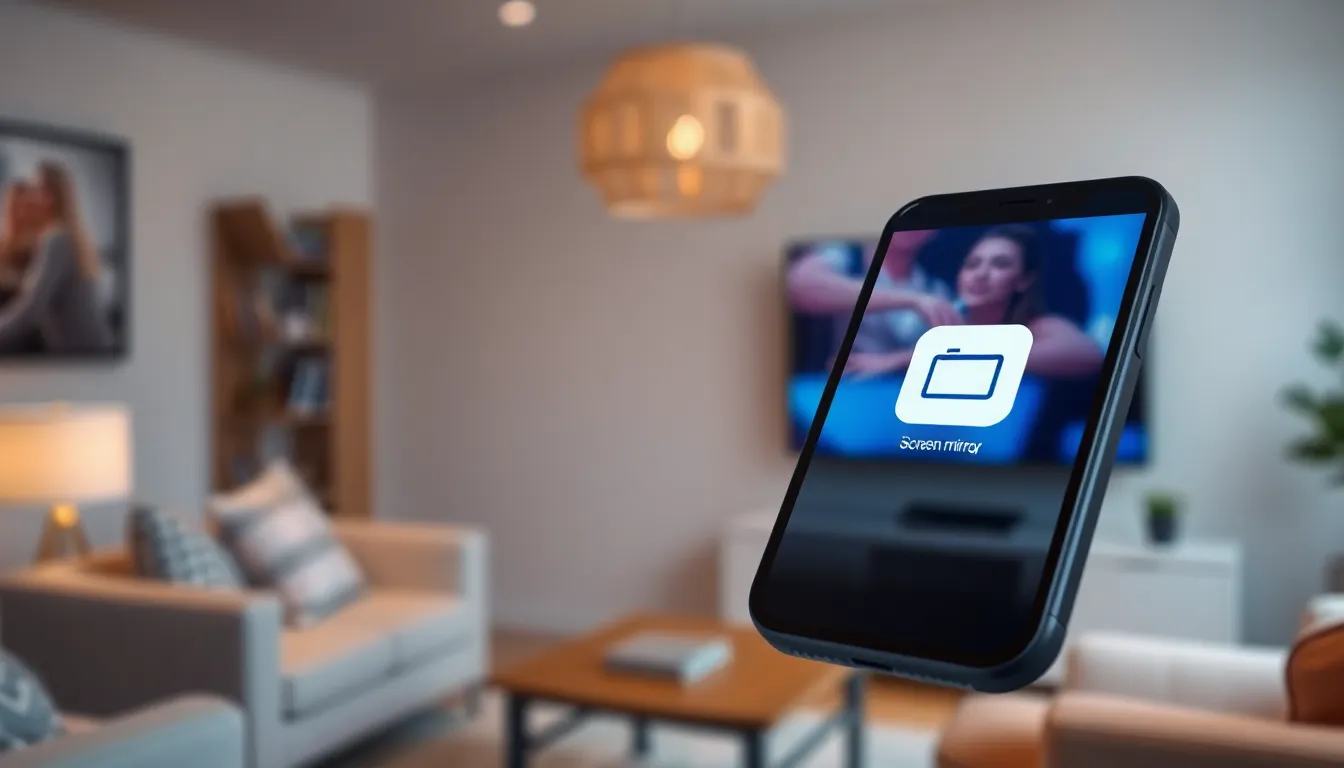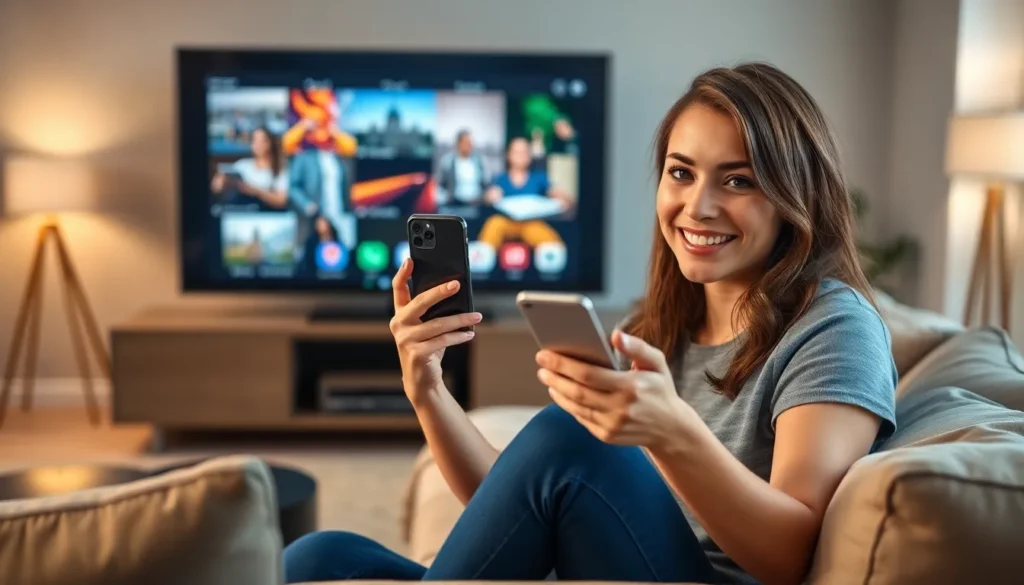Table of Contents
ToggleEver found yourself in a situation where you wish you could share that hilarious cat video or your latest vacation snaps on a bigger screen? You’re not alone! Screen mirroring on an iPhone is like having a magic portal that transforms your tiny device into a cinematic experience. But wait—where is it hiding?
Understanding Screen Mirroring
Screen mirroring allows an iPhone to transmit its display to another screen, such as a smart TV or projector. Users can share videos, photos, and even apps on larger screens for enhanced viewing experiences. To access screen mirroring, users typically find it in the Control Center.
Control Center can be opened by swiping down from the top-right corner on iPhone models without a Home button. For older models with a Home button, swiping up from the bottom edge reveals the Control Center. Looking for the screen mirroring icon becomes essential once in the Control Center. The icon resembles two overlapping rectangles, often located near the volume controls.
Selecting the screen mirroring option prompts a list of available devices. Users can then connect to a compatible screen by tapping on its name. Once connected, anything viewed on the iPhone mirrors on the larger display. Enjoyable options for screen mirroring include watching movies, playing games, or giving presentations.
Screen mirroring incorporates AirPlay technology, which enhances compatibility between Apple devices. Most modern smart TVs support AirPlay, simplifying the connection process. Users can also check if their TV or device is compatible with screen mirroring using the manufacturer’s guidelines.
Sometimes, issues arise with screen mirroring connections. Users may experience lag or disconnection due to Wi-Fi interference or distance between the iPhone and the display. Ensuring proper connection and proximity often resolves these issues.
How To Access Screen Mirroring

Accessing screen mirroring on an iPhone is straightforward. Users can easily share their display with compatible devices via the Control Center.
For iOS Devices
To find screen mirroring on iOS devices, swipe down from the top-right corner on models with Face ID or swipe up from the bottom edge on models with a Home button. Look for the screen mirroring icon that resembles two overlapping rectangles. Tapping this icon opens a list of available devices for connection. Users can select a compatible device and start mirroring their display instantly, enhancing activities such as streaming shows and viewing photos.
For Apple TV
Connecting to Apple TV involves a similar process. After accessing the Control Center, tap the screen mirroring icon. A list appears, showcasing available Apple TV devices. Selecting the desired Apple TV establishes the connection quickly. Once connected, users can easily stream content, play games, or share presentations on the larger screen, maximizing the entertainment experience.
Common Issues and Troubleshooting
Screen mirroring on an iPhone can sometimes encounter challenges. Addressing these issues quickly improves the user experience.
Connection Problems
Connection problems often arise when the iPhone fails to locate available devices. Users should confirm that both the iPhone and the receiving device are connected to the same Wi-Fi network. Restarting the router and the devices can also resolve connectivity issues. Updating the iOS on the iPhone to the latest version might fix software-related problems. A low battery on the iPhone can also contribute to inconsistent performance.
Audio and Video Sync Issues
Audio and video sync issues are frustrating during presentations or movie streaming. Delayed audio often occurs due to a weak, unstable Wi-Fi connection. Ensuring a strong signal will help mitigate this problem. Users should check for updates for their devices, as outdated software might create sync discrepancies. Adjusting the settings on the receiving device may also enhance synchronization. A simple reboot of the iPhone can sometimes rectify latency problems, enabling a smoother viewing experience.
Benefits of Screen Mirroring
Screen mirroring provides numerous advantages for iPhone users. Enhancing presentations is one significant benefit; sharing slideshows on a larger screen helps capture audience attention. Watching movies becomes more enjoyable when displayed on a smart TV, offering a cinematic experience in the comfort of home.
Gaming also sees improvement. Players can experience gameplay on a bigger screen, enhancing immersion and interaction. Sharing photos with friends or family adds a social aspect that personalizes gatherings. Instead of crowding around a small screen, users can present images to everyone easily.
Convenience plays a key role as well. Accessing apps and content directly from an iPhone makes navigation seamless. Control options available through screen mirroring offer instant adjustments.
Cost-effectiveness emerges as another advantage; users can utilize existing devices like smart TVs without purchasing additional hardware. Multiple device compatibility ensures users can connect to various systems, increasing utility across different platforms.
Furthermore, educational benefits materialize when using screen mirroring in classrooms. Teachers can share resources and interactive lessons, enhancing student engagement. This approach encourages collaborative learning and participation.
Simplicity of setup enhances user experience. Connecting devices requires easy steps, allowing users to begin enjoying benefits almost immediately. Initiating screen mirroring does not require technical expertise, making it accessible for everyone.
Overall, screen mirroring transforms how users interact with their devices, elevating entertainment, productivity, and learning while remaining user-friendly.
Alternatives to Screen Mirroring
Several effective alternatives exist for sharing content from an iPhone to a larger screen without using screen mirroring. Users can rely on HDMI adapters to connect directly to TVs or monitors. Lightning to HDMI adapters allow quick plug-and-play functionality, requiring no complex setup.
Another option involves utilizing Apple’s AirPlay feature for streaming content directly to compatible devices. This method enables the sharing of videos or music without mirroring the entire device screen. Apple TV stands out as a primary device for seamless AirPlay usage, enabling direct streaming from apps like Netflix and YouTube.
Third-party applications provide additional avenues for content sharing. Many streaming services offer casting options to send videos from iPhones to smart TVs, allowing users to control playback directly from their devices. Chromecast serves as a popular choice for those with compatible TVs, enabling quick and easy streaming.
Users may also consider using smart TV apps that support iPhone connectivity. Many smart TVs now have dedicated applications designed to work with iPhones, allowing users to browse and share media effortlessly. This option enhances accessibility and creates a smoother experience.
Wireless displays offer yet another alternative for screen sharing. Devices such as Roku and Miracast allow users to connect their iPhones to larger screens without a direct cable connection, providing flexible options for content sharing.
Employing these alternatives ensures users can effectively share their iPhone content. Each method provides unique advantages depending on user preferences and available equipment, allowing for an enhanced viewing experience without solely relying on traditional screen mirroring methods.
Finding screen mirroring on an iPhone opens up a world of possibilities for sharing content on larger screens. With just a few taps in the Control Center users can easily connect to smart TVs or projectors. This feature enhances the viewing experience whether it’s for movies presentations or gaming.
While occasional connectivity issues may arise users can resolve them with simple troubleshooting steps. By ensuring a strong Wi-Fi connection and keeping devices updated users can enjoy seamless screen mirroring.
With various alternatives available users can choose the method that best fits their needs. Embracing screen mirroring transforms how iPhone users interact with their devices enriching entertainment and productivity.




